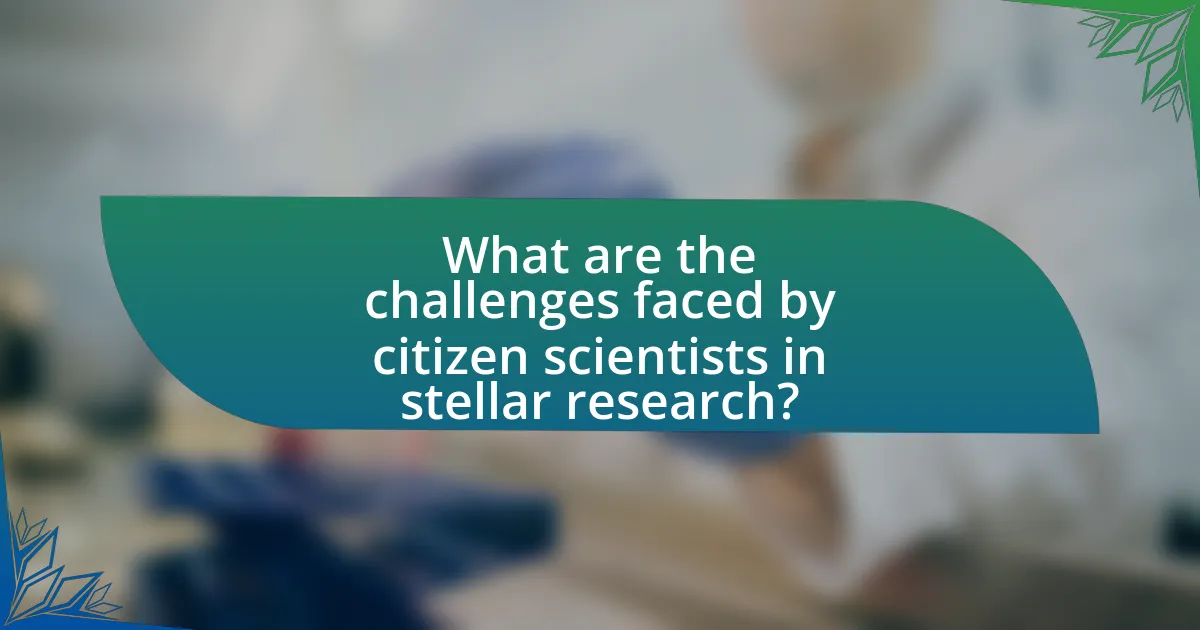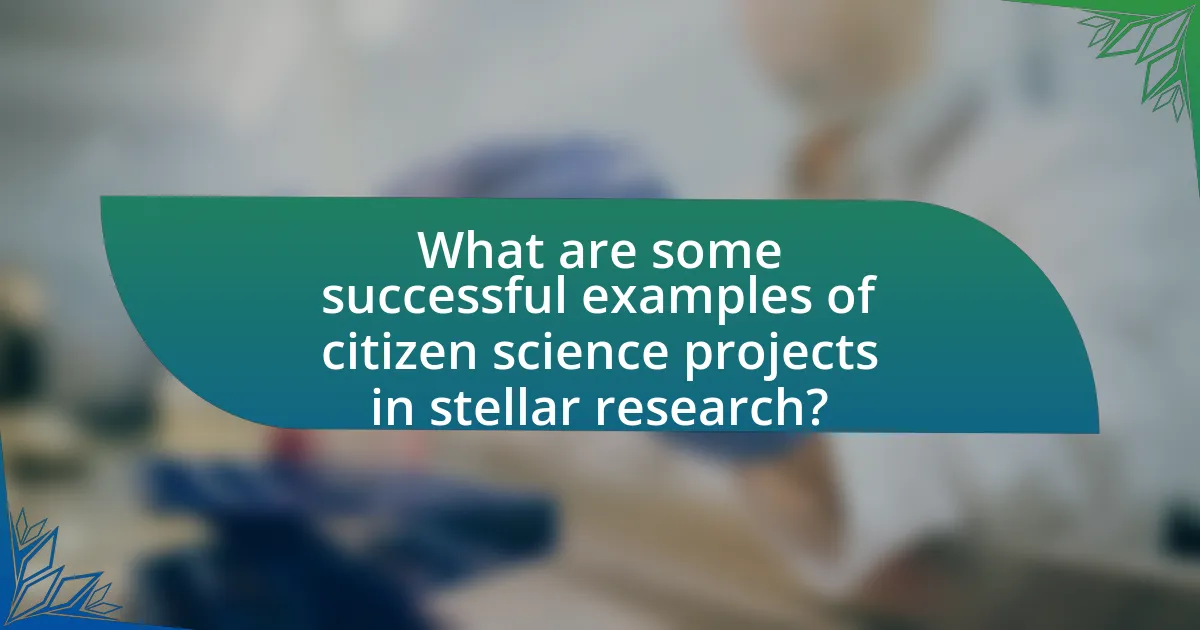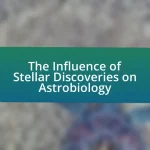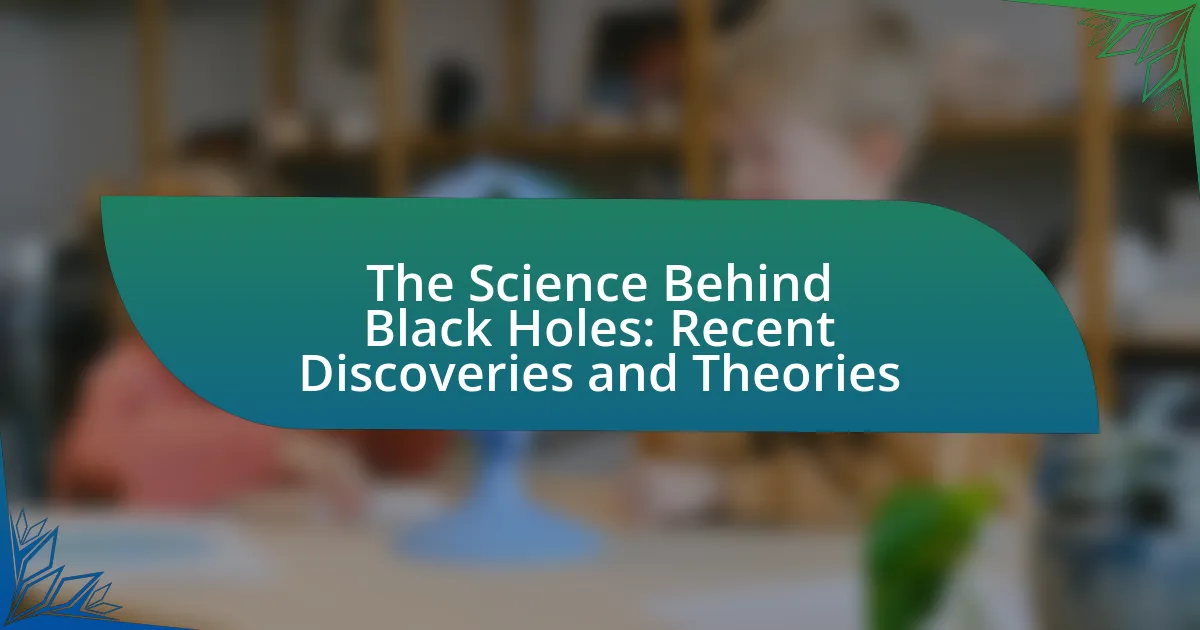Citizen scientists play a vital role in stellar research by actively participating in data collection, analysis, and the discovery of celestial phenomena. Through projects like Galaxy Zoo and Planet Hunters, they contribute to monitoring variable stars, classifying galaxies, and identifying exoplanets, significantly enhancing the volume of data available for professional astronomers. Despite facing challenges such as limited access to technology and the need for data validation, citizen scientists collaborate effectively with experts, ensuring the quality of their contributions through training and standardized protocols. Successful initiatives demonstrate the impact of citizen involvement in advancing our understanding of the universe, highlighting future opportunities for engagement in astronomical research.

What is the Role of Citizen Scientists in Stellar Research?
Citizen scientists play a crucial role in stellar research by contributing data collection, analysis, and discovery efforts that enhance our understanding of the universe. They engage in activities such as monitoring variable stars, classifying galaxies, and identifying exoplanets through projects like Galaxy Zoo and Planet Hunters. These contributions are significant; for instance, the Kepler Space Telescope’s data analysis involved citizen scientists who helped identify thousands of potential exoplanets, demonstrating the impact of public participation in professional scientific endeavors.
How do citizen scientists contribute to the field of stellar research?
Citizen scientists contribute to the field of stellar research by participating in data collection, analysis, and discovery of celestial phenomena. They engage in projects such as monitoring variable stars, identifying exoplanets, and classifying galaxies, which enhances the volume of data available for professional astronomers. For instance, the Planet Hunters project allows volunteers to analyze light curves from Kepler space telescope data, leading to the discovery of new exoplanets. This collaborative effort not only accelerates research but also democratizes science, allowing non-professionals to contribute valuable insights and findings that can lead to significant advancements in our understanding of the universe.
What specific tasks do citizen scientists perform in stellar research?
Citizen scientists perform various specific tasks in stellar research, including data collection, analysis, and classification of astronomical objects. They often engage in monitoring variable stars, identifying exoplanets through transit methods, and contributing to the cataloging of celestial phenomena. For instance, projects like Galaxy Zoo allow citizen scientists to classify galaxies based on their shapes, which aids in understanding galaxy formation and evolution. Additionally, platforms such as Zooniverse enable volunteers to analyze large datasets from telescopes, enhancing the research capabilities of professional astronomers. These contributions are vital, as they help process vast amounts of data that would be unmanageable for scientists alone.
How do citizen scientists collaborate with professional astronomers?
Citizen scientists collaborate with professional astronomers by participating in data collection, analysis, and interpretation of astronomical phenomena. These collaborations often occur through structured programs where citizen scientists contribute to large-scale projects, such as monitoring variable stars or identifying exoplanets, using online platforms and tools provided by professional institutions. For instance, projects like Galaxy Zoo allow volunteers to classify galaxies, which aids researchers in understanding galaxy formation and evolution. This partnership enhances research capabilities by leveraging the collective efforts of thousands of volunteers, resulting in significant contributions to scientific knowledge and discoveries.
Why is citizen science important in the study of stars?
Citizen science is important in the study of stars because it significantly expands the capacity for data collection and analysis in astronomy. By involving non-professional astronomers, citizen science projects like Galaxy Zoo and the Planet Hunters have enabled the classification of millions of celestial objects and the discovery of new exoplanets, respectively. These initiatives leverage the collective efforts of volunteers, allowing for large-scale observations that would be impractical for professional astronomers alone. For instance, Galaxy Zoo has classified over 2 million galaxies, providing valuable insights into galaxy formation and evolution. This collaborative approach not only accelerates research but also democratizes science, making astronomical discoveries accessible to a broader audience.
What unique perspectives do citizen scientists bring to stellar research?
Citizen scientists bring diverse perspectives to stellar research by contributing unique observational data and local knowledge. Their involvement often leads to the discovery of new celestial phenomena, as seen in projects like Galaxy Zoo, where volunteers classified millions of galaxies, resulting in significant findings such as the identification of rare galaxy types. Additionally, citizen scientists can enhance public engagement and awareness of astronomical research, fostering a broader understanding of the universe. This grassroots participation not only democratizes science but also enriches the research community with varied insights and innovative approaches to problem-solving.
How does citizen science enhance data collection and analysis in astronomy?
Citizen science enhances data collection and analysis in astronomy by mobilizing large numbers of volunteers to contribute observations and data processing. This approach significantly increases the volume of data that can be collected, as seen in projects like Galaxy Zoo, where over 100,000 volunteers classified millions of galaxies, leading to discoveries such as the identification of new galaxy types. Furthermore, citizen scientists often assist in analyzing data from telescopes, which accelerates the pace of research and allows professional astronomers to focus on more complex tasks. The collaborative nature of citizen science also fosters diverse perspectives, enriching the analysis process and leading to innovative solutions in astronomical research.

What are the challenges faced by citizen scientists in stellar research?
Citizen scientists in stellar research face several challenges, including limited access to advanced technology, lack of formal training, and difficulties in data validation. Limited access to sophisticated telescopes and software restricts their ability to conduct high-quality observations. Additionally, many citizen scientists may not have the formal education or training in astrophysics necessary to interpret complex data accurately. Data validation poses another significant challenge, as citizen scientists must ensure their findings are credible and align with established scientific standards, which can be difficult without expert guidance. These challenges can hinder the overall contribution of citizen scientists to the field of stellar research.
What obstacles do citizen scientists encounter when participating in research?
Citizen scientists encounter several obstacles when participating in research, including lack of training, limited access to resources, and difficulties in data validation. These challenges can hinder their ability to contribute effectively to scientific projects. For instance, many citizen scientists may not have the necessary background knowledge or skills to accurately collect and analyze data, which can lead to errors. Additionally, access to specialized tools or platforms for data collection may be restricted, limiting their participation. Furthermore, ensuring the reliability of the data collected by citizen scientists can be problematic, as researchers often require rigorous validation processes to confirm findings.
How can citizen scientists overcome technical challenges in data analysis?
Citizen scientists can overcome technical challenges in data analysis by utilizing accessible software tools and online platforms designed for non-experts. These tools often include user-friendly interfaces and tutorials that simplify complex data processing tasks. For instance, platforms like Galaxy and Zooniverse provide guided workflows that help users analyze astronomical data without requiring advanced programming skills. Additionally, citizen scientists can participate in training workshops and online courses that enhance their data analysis skills, as evidenced by programs offered by organizations such as the American Association of Variable Star Observers, which has successfully trained thousands of volunteers in data handling techniques.
What resources are available to support citizen scientists in their efforts?
Citizen scientists can access various resources to support their efforts, including online platforms, educational materials, and community networks. Websites like Zooniverse and Galaxy Zoo provide citizen scientists with tools to analyze astronomical data and contribute to research projects. Additionally, organizations such as the American Association of Variable Star Observers (AAVSO) offer training resources and data collection tools specifically for monitoring variable stars. Furthermore, social media groups and forums facilitate collaboration and knowledge sharing among citizen scientists, enhancing their ability to engage in stellar research effectively.
How do citizen scientists ensure the quality of their contributions?
Citizen scientists ensure the quality of their contributions through rigorous training, standardized protocols, and peer review processes. Training programs equip citizen scientists with the necessary skills and knowledge to accurately collect and analyze data, while standardized protocols provide clear guidelines for data collection and reporting. Additionally, many projects incorporate peer review mechanisms where contributions are evaluated by experienced researchers or fellow citizen scientists, ensuring that the data meets established scientific standards. This multi-faceted approach enhances the reliability and validity of the contributions made by citizen scientists in stellar research.
What methods are used to validate the findings of citizen scientists?
The findings of citizen scientists are validated through several methods, including peer review, cross-validation with professional data, and the use of standardized protocols. Peer review involves experts evaluating the citizen scientists’ data and methodologies to ensure accuracy and reliability. Cross-validation occurs when citizen-generated data is compared against established datasets from professional astronomers, confirming consistency and correctness. Standardized protocols provide guidelines for data collection and analysis, ensuring that citizen scientists follow best practices, which enhances the credibility of their findings. These methods collectively ensure that the contributions of citizen scientists are both accurate and valuable to the scientific community.
How do citizen scientists receive training and guidance in stellar research?
Citizen scientists receive training and guidance in stellar research through structured programs, online platforms, and collaborative projects with professional astronomers. These programs often include tutorials, webinars, and hands-on activities that teach participants how to analyze astronomical data, identify celestial objects, and contribute to ongoing research initiatives. For example, organizations like Zooniverse provide citizen scientists with access to user-friendly interfaces and educational resources that facilitate their involvement in real scientific projects, such as classifying galaxies or monitoring variable stars. This approach not only empowers citizen scientists but also enhances the quality of data collected, as evidenced by successful projects that have led to significant astronomical discoveries.

What are some successful examples of citizen science projects in stellar research?
Successful examples of citizen science projects in stellar research include Galaxy Zoo, which has engaged over 150,000 volunteers to classify galaxies based on their shapes, leading to significant discoveries about galaxy formation and evolution. Another notable project is the Planet Hunters initiative, where citizen scientists have contributed to the identification of exoplanets by analyzing light curves from Kepler data, resulting in the confirmation of numerous new planets. Additionally, the Stardust@home project allowed participants to search for interstellar dust particles in samples collected by NASA’s Stardust mission, enhancing our understanding of cosmic materials. These projects demonstrate the impactful contributions of citizen scientists in advancing stellar research.
What notable projects have involved citizen scientists in studying stars?
Notable projects that have involved citizen scientists in studying stars include the Galaxy Zoo project and the Planet Hunters initiative. Galaxy Zoo, launched in 2007, engaged volunteers in classifying galaxies based on their shapes, contributing to a better understanding of galaxy formation and evolution. The Planet Hunters project, initiated in 2010, allowed citizen scientists to analyze data from the Kepler space telescope to identify potential exoplanets, leading to the discovery of numerous new planetary systems. Both projects exemplify how citizen contributions have significantly advanced astronomical research and data analysis.
How have these projects impacted our understanding of stellar phenomena?
Citizen science projects have significantly enhanced our understanding of stellar phenomena by enabling large-scale data collection and analysis that would be impossible for professional astronomers alone. These initiatives, such as the Planet Hunters and Galaxy Zoo, have engaged thousands of volunteers in classifying stars and galaxies, leading to the discovery of new exoplanets and the identification of rare stellar events. For instance, the Kepler Space Telescope’s data analysis by citizen scientists resulted in the identification of over 2,300 confirmed exoplanets, expanding our knowledge of planetary systems and their formation. This collaborative approach has democratized astronomical research, allowing diverse contributions that enrich scientific insights and foster a deeper public interest in astronomy.
What lessons can be learned from successful citizen science initiatives?
Successful citizen science initiatives demonstrate the importance of community engagement and collaboration in scientific research. These initiatives show that involving non-professionals can significantly enhance data collection and analysis, as evidenced by projects like Galaxy Zoo, which utilized volunteers to classify millions of galaxies, leading to new discoveries in astrophysics. Furthermore, successful initiatives highlight the need for clear communication and training, ensuring that participants understand their roles and the scientific goals, which has been shown to improve data quality and participant satisfaction. Lastly, these projects often reveal the value of leveraging technology, such as mobile apps and online platforms, to facilitate participation and data sharing, thereby expanding the reach and impact of scientific research.
What future opportunities exist for citizen scientists in stellar research?
Future opportunities for citizen scientists in stellar research include participation in large-scale astronomical surveys, data analysis through citizen science platforms, and collaboration on research projects with professional astronomers. As technology advances, citizen scientists can utilize tools like machine learning algorithms to analyze vast datasets from telescopes, such as the Vera C. Rubin Observatory’s Legacy Survey of Space and Time, which is expected to generate petabytes of data. Additionally, initiatives like Galaxy Zoo allow citizen scientists to classify galaxies, contributing to our understanding of cosmic structures. These opportunities are supported by the increasing accessibility of astronomical data and the growing recognition of citizen contributions in scientific research.
How can emerging technologies enhance citizen science in astronomy?
Emerging technologies can enhance citizen science in astronomy by providing advanced tools for data collection, analysis, and collaboration. For instance, the use of artificial intelligence algorithms allows citizen scientists to process vast amounts of astronomical data more efficiently, identifying patterns and anomalies that would be difficult for humans to detect alone. Additionally, mobile applications and online platforms facilitate real-time data sharing and communication among citizen scientists, enabling collaborative projects that can lead to significant discoveries. A notable example is the Galaxy Zoo project, which utilizes crowdsourcing to classify galaxies, demonstrating how technology can leverage the collective efforts of volunteers to contribute to scientific research.
What trends are shaping the future of citizen involvement in stellar research?
Emerging trends shaping the future of citizen involvement in stellar research include increased accessibility to data, advancements in technology, and collaborative platforms. Accessibility to astronomical data has expanded significantly, with initiatives like the Sloan Digital Sky Survey providing open access to vast datasets, enabling citizen scientists to contribute to research. Advancements in technology, such as mobile applications and user-friendly software, allow non-experts to analyze complex data effectively. Collaborative platforms, like Zooniverse, facilitate community engagement by connecting amateur astronomers with professional researchers, fostering a participatory research environment. These trends collectively enhance the role of citizen scientists in contributing valuable insights to stellar research.
What best practices should citizen scientists follow in stellar research?
Citizen scientists should follow systematic observation, accurate data recording, and collaboration with professional astronomers as best practices in stellar research. Systematic observation involves using established protocols to ensure consistency and reliability in data collection, which is crucial for scientific validity. Accurate data recording requires meticulous documentation of observations, including time, location, and conditions, to facilitate analysis and verification. Collaboration with professional astronomers enhances the quality of research, as citizen scientists can benefit from expert guidance and access to advanced tools and resources, thereby increasing the impact of their contributions. These practices are supported by successful citizen science projects, such as Galaxy Zoo, which demonstrated that structured participation can yield significant scientific discoveries.




